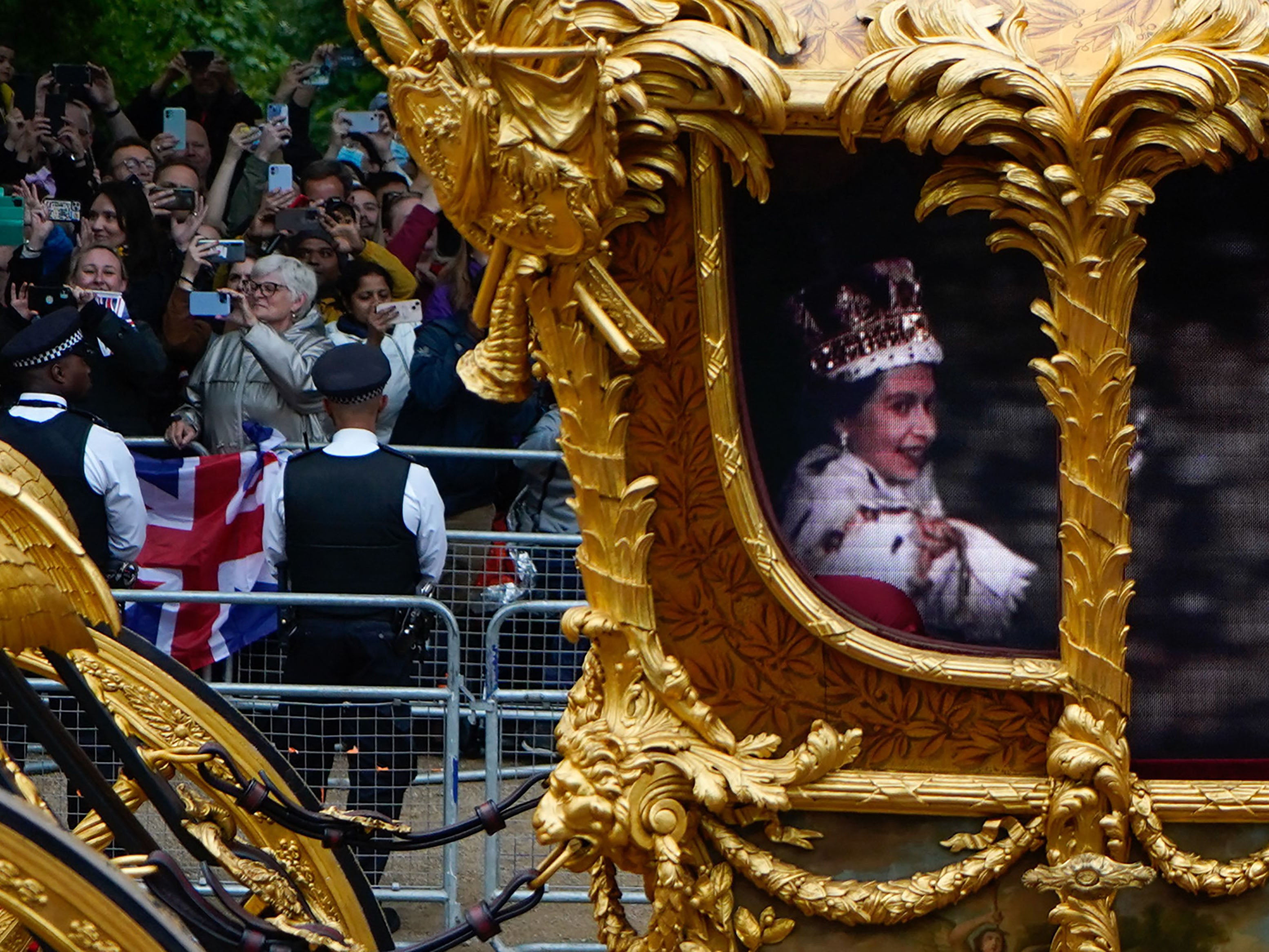First Abba, then the Queen – this is why we’re so fascinated with the concept of the hologram
The stage-managed technological extravaganza confirms our obsession with the safety and security of our past


Among all the national pomp and ceremony that glittered like gold during the Queen’s platinum jubilee celebrations last weekend, the virtual hologram of a 25-year-old majesty waving at the cheering crowds was perhaps the pageant’s most spectacular, and certainly its most innovative.
The computerised image, captured from archival footage of the monarch filmed during her 1953 coronation, gave the convincing impression that the Queen was seated not at home, but inside the famous Gold State Coach used by the royal family at the coronation of every British monarch since George IV.
This time, however, it was the trickery of a modern digital display that projected Her Majesty as she appeared almost seven decades ago onto the windows of the carriage on Sunday afternoon. Flanked by guardsmen on horseback to complete the illusion, the CGI Queen was glimpsed enthusiastically gesturing to the crowds while the 260-year-old carriage made its way down the Mall and through the cheering streets of London.
Though the technology was intended as a precaution given the expected toll by the Jubilee fanfare upon the 96-year-old monarch, last week’s celebratory parade was not the first time HRH has been the subject of sophisticated digital manipulation. Back in 2012, Ontario-born artist Chris Levine created a holographic image in honour of the Queen’s diamond jubilee, which was itself based upon his earlier 2004 portrait Equanimity.
Dubbed The Diamond Queen (and including a re-creation of the Queen’s diamond diadem first worn in 1953), Levine’s advanced 3D illuminated portrait presented an effect akin to that of Pepper’s Ghost – a conjuring trick devised by English scientist John Henry Pepper involving reflective plates of glass and light projection popularised in the spooky ghost stories of late-19th century Victorian theatres.
More recently, and as part of the exhibition to mark 200 years since the birth of Queen Victoria in 2019, the ballroom of Buckingham Palace updated the principles of this same Victorian illusion technique, with a similar 3D hologram recreating a waltz from a ball marking the conclusion of the Crimean war in 1856.
The ability to conjure youthful – and even ‘posthumous’ appearances – via sophisticated computer processing remains a widely-used, if hotly contested, production technique within today’s multimedia landscape. The platinum jubilee’s digital display comes, of course, a mere fortnight after the premiere of the much-anticipated Abba Voyage virtual concert tour. The 90-minute live show features 3D computer holograms (or ‘Abbatars’) created with motion-capture techniques and performance doubles, all modelled on the Swedish band’s look from their Seventies and Eighties heyday.
We have seen this kind of CG illusion before. Thanks to arts-and-science intervention, musicians Elvis Presley, Michael Jackson, Tupac, and Whitney Houston have all posthumously appeared in new ‘live’ stage performances several years after their deaths (though plans for a new live tour featuring Amy Winehouse in 2019 were scrapped).
To keep up to speed with all the latest opinions and comment sign up to our free weekly Voices Dispatches newsletter by clicking here
Even television advertising has got in on the act, using computer graphics to feature everything from a breakdancing Gene Kelly (used by Volkswagen for its Golf GTI ad campaign) to a Galaxy chocolate advert from 2013 starring a 1950s-era Audrey Hepburn. Over in Hollywood, digital de-aging has become a growing trend within an industry known for its expendability, with actors Robert De Niro, Robert Downey Jr, Will Smith, and Michael Douglas all given a hand by the computer to simulate their younger selves.
Yet in an era when men are permitted to both age onscreen and routinely afforded an array of digital beauty VFX, the gendered dimension of the virtual recreation of youth does nothing to alleviate the widespread view that it is female stars who have an insidious built-in obsolescence that drastically limits their visibility after a certain age.
But what do these dancing queens and de-aged celebrities have to say about the power of nostalgia in an era where past glories carry such potent political currency? While technological nips and tucks have been a common (albeit widely denied) feature of the fashion and advertising industries for years, the stage-managed technological extravaganza that marked the Queen’s platinum celebrations confirms our broader fascination with the safety and security of our national past.
When the ‘good old days’ in our current economic climate are placed on a collision course with technological wizardry, these haunting and uncanny CG apparitions offer something close to comfort by freezing the image of the rich and famous at moments of iconic perfection. After all, who better to signal our cultural desires to delay the passing of time than the stars of stage and screen?
From the sublime to the flawless, the ethics of simulated youth and ‘posthumous’ screen performances remain not without their critics. But with the potential for British royalty to now live on in three dimensions beyond just a possible future, the multimedia prospects for this technological fakery suggest the computer will come to tell many more ghost stories.
Join our commenting forum
Join thought-provoking conversations, follow other Independent readers and see their replies
Comments